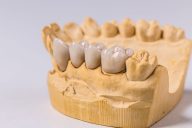AESTHETIC PROCEDURES
Upgrade your smile!
Composite veneers (bonding)
Composite veneers (bonding) is a quick, easy, and effective way to address a variety of minor concerns :
- A single discolored tooth
- Small gaps between teeth
- Little chips, cracks, or cavities
- Improperly shaped tooth
The material used in dental bonding is a biocompatible dental composite material ,the same material used to restore caries and is similar to tooth enamel and matches the color of your teeth.
It can be used to make large aesthetic improvements or smaller repairs like fixing chipped or discolored teeth.
This will improve the appearance of your smile without requiring invasive dental procedures such as crowns or veneers.
This procedure is usually completed during one visit to the dentist and can last anywhere from five to ten years with good oral hygiene and regular control visits.
WHAT TO EXPECT
- Colour matching : Together we choose the composite material to match the shade of your natural teeth.
- Tooth preperation : It may be needed to prepare a small portion of the tooth surface in order to reshape it properly and make the restoration look as natural as possible.
- Bonding : We aply the composite material with the bonding agent with a biomimetic technique and with a UV light we cure & seal it.
- Contouring & polishing : We finish and polish the restoration.
- Smile!
Porcelain veneers
Minimally invasive restorations!
Porcelain veneers are custom-made, cosmetic, partial coverage restorations that change the shape, color and sometimes the position of teeth.
A thin layer of ceramic is bonded to the front surface of natural teeth. The new generation of porcelain veneers is made through CAD/CAM technology and are customized based on each patient’s unique morpho-functional characteristics.
Indications
- Close spaces between teeth.
- Correct small mallpositions of teeth.
(when orthodontic treatment is not suitable) - Restore the shape and size of teeth.
(due to abrasion or micro-fractures) - Cover teeth with big extensive obturations.
- Permanent whitening of the teeth.
WHAT TO EXPECT
- Examination and analysis of the clinical case.
- The proposed design is transferred onto the natural teeth without any preparation, thus creating an immediate simulation. The patient leaves and tries on their simulation in the mouth for 2-3 days and if everything is in order, the final design is transferred to the dental technician. The ceramic veneers are manufactured one by one in a special CAD/CAM guided design device.
- Minimal preparation of the vestibular surfaces of the teeth treated with the veneers.
- Construction of transitional-temporary restorations.
- Impressions are taken by the prepared teeth.
- Fabrication by the dental technician of the final feldspathic or lithium disilicate (e-max) veneers.
- Bonding of the veneers.
- Smile!
Composite veneers vs Porcelain veneers
TOOTH BONDING
Single visit restorations
Lasts 4-8 years
Prone to chipping can be easily restored
Esthetic
Stains like natural teeth
Takes correction once bonded
Less expensive
PORCELAIN VENEERS
Multiple visits restorations
Lasts 10-15 years
If chipped has to be replaced
Extremely esthetic
Does not stain
No corrections once bonded
More expensive
Tooth whitening
Briliant white smile!
Teeth whitening is one of the most popular cosmetic dentistry procedures. Achieving a more attractive smile can lift your spirits and boost self-esteem, in addition to improving overall dental health by removing stains that come from drinking coffee or smoking.
It is a non-invasive procedure and is the most common way to whiten teeth. The active ingredient in tooth-whitening procedures—such as gels for in-office application and trays you wear at home—is typically carbamide peroxide: when moisture in the mouth touches it, this chemical breaks down into hydrogen peroxide which affects the teeth by making them whiter and brightening them.
The most common method is whitening the teeth with an in-office procedure or at home using home tooth whitening kits.
With one visit we will determine whether you are a good candidate for tooth whitening and which type of procedure is best for your situation.
In-office laser tooth whitening
Laser whitening is done in one appointment and the session lasts about an hour in total.
- We first isolate the gums and lips with a special isolation material so that the whitening agent (gel) does not come into contact with the soft tissues and cause irritation.
- The whitening gel is then placed on the outer surface of the teeth that will undergo whitening.
- Then it is activated with the help of the diode laser for 2.5 minutes and left to act for 20 minutes.
This process is repeated twice. - Finally, all the materials are removed and then we apply a desensitizing gel and you now have a brand new bright smile!
Home tooth whitening kit
Whitening at the comfort of your home is carried out using individual trays (transparent splints) made from impressions taken from the patient and a special whitening gel given by the doctor.
The patient places the whitening agent (gel) inside the splint according to the instructions given to him.
Then they are worn 2 to 8 hours (depending on the content of the whitening agent) during the day or at night while sleeping.
The duration of treatment depends on the degree of discoloration.
An average duration of treatment ranges from 10-15 days.
Also, even after the end of the treatment, the splints can be used to maintain and renew the result for years to come, if the patient takes care of them properly.
In-office laser whitening and home tooth whitening kit combination
Most of our patients prefer to use that method.
Usually, before the in-office laser whitening session individual whitening trays are fabricated and the treatment continues at home for 4-5 days (maybe more depending the staining level).
In this way, the whitening effect is further enhanced and is recommended in cases where the aesthetic requirements are intense.
Also in this case the splints can be used in the future to maintain the result.
Frequently asked questions
You should avoid eating foods and drinks with dyes such as red sauces, beets, red fruits, red wine, coffee, spices, etc. This diet avoiding foods with strong dyes should be applied both during of the treatment as well as for a period of at least one week after the teeth whitening treatment.
Whitening substances are only active on natural teeth and not on artificial restorations such as fillings, crowns, bridges or resin / porcelain veneers. Therefore if the prosthetic restorations are extensive, whitening is not possible. In the case of localized restorations, their replacement after the bleaching treatment may be necessary if a significant difference in color occurs.
Bleaching is contraindicated in pregnant and lactating women due to insufficient data on any effects on fetal development and the composition of the breast milk.
The answer is no.
When the whitening process, is carried out under the control of the dentist and with the use of modern and approved whitening agents, it is completely safe.
Whitening does not destroy tooth enamel or damage the teeth, as long as the whitening materials are the ones used in the in-office procedure and home whitening kit recommended by your dentist.
The only symptom that can occur is a slight sensitivity of the teeth, which is temporary, usually lasts 2-3 days and can be treated with special desensitizing agents provided by the dentist.
A necessary condition for a successful whitening is that the patient has healthy tooth and gingival tissues. In case of pre-existing gingivitis, decayed or broken teeth or obturations that need to be changed, the necessary treatment to clean the teeth from tartar and dental plaque and any other dental treatment deemed necessary to restore oral health will need to be preceded.
Only then can the whitening agents act seamlessly on the clean dental tissues and not irritate the soft tissues.
Bleaching can be done once the eruption of all permanent teeth has been completed, i.e. at the age of 18 years and above.
The effect of the tooth whitening procedure is not permanent.
The teeth will not return to their original color, however, the whitening effect will fade over time.
Of course, the result of the treatment is maintained very easily with a repeated dose of whitening approximately once a year using a home whitening kit for approximately 7-10 days.
The duration of the whitening treatment and the need for maintenance depends greatly on the individual habits of the patient. The more often teeth-staining foods and drinks are consumed, the faster the teeth will tend to return to their original color.
Good oral hygiene also plays an important role in maintaining the result.
The use of commercial bleaching products should be avoided. Buying a random preparation whose composition and safety is not tested and excessive or incorrect use by the patient can lead to side effects such as excessive tooth sensitivity, painful gum irritation without having the desired results.
Commercially available whitening toothpastes do not whiten teeth. Dentists recommend them to maintain the result after whitening treatment. However, care is required in the choice of toothpaste because some contain abrasive grains that wear away the enamel of the teeth with destructive effects on the natural dental substance.
Also, some whitening products sold in pharmacies may cause you a problem, depending on the condition of your mouth, and it is advisable to consult your dentist before proceeding with such a purchase.















